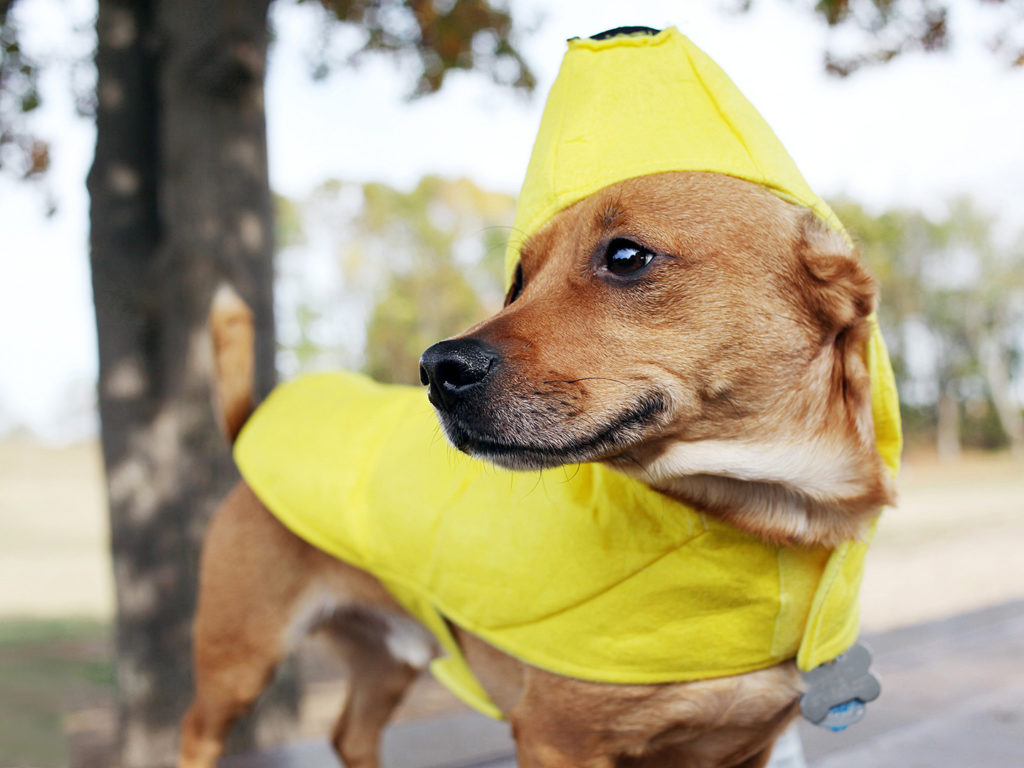Finding the Purr-fect Pet Halloween Costume

With spooky season right around the corner, many pet owners have begun their hunt for their furry friend’s perfect Halloween costume. But finding a costume that is both festive and safe can be a challenge.
Dr. Lori Teller, a clinical associate professor at the Texas A&M College of Veterinary Medicine & Biomedical Sciences, offers some guidance on what to look for to ensure that the holiday isn’t so tricky for your pet.
While many pets are tolerant of costumes, a costume has the potential to bring about unneeded stress and anxiety. Knowing your animal’s level of comfort with a costume is important for their well-being and safety.
“Some dogs and cats will just freeze and not be willing to move when put in a costume,” Teller said. “Others may whine, paw, or chew at various parts of the costume to try and get it off.”
If your pet is noticeably uncomfortable in their costume, it is best to leave the costume at home, allowing them to enjoy the night.
For those that are costume-tolerant, the primary concern in dressing your pet is whether the costume limits their pet’s ability to see, hear, breathe, or move. If any of these abilities are restricted in the slightest way, the costume should be avoided.
“Costumes that interfere with a pet’s ability to move or see increases the animal’s risk of falling, tripping, or getting loose,” Teller said.
Owners should evaluate costumes for loose, hanging pieces, which can present fire hazards if the pet walks too close to Halloween décor involving lit candles.
“If an animal chews at the costume, they also have the potential to choke and end up with a foreign body that could cause gastrointestinal obstruction,” Teller said.
A pet’s ambient temperature should also be taken into account.
“If it is warm outside and your pet is in a thick costume, the animal may be at higher risk of heat stroke,” Teller said. “This could be exacerbated if your pet gets excited and overheated when trick-or-treating.”
Pet owners may also be interested in using dyes or paints to “DIY” a costume for their furry friend.
“In general, if these particular products are labeled as ‘pet-safe’ then your animal should be OK,” Teller advised. “With that being said, every animal is different, so if your animal has sensitive skin, it would be better to avoid these products.”
When applying pet-safe dyes or paints, avoid areas around and on the animal’s eyes, ears, nose, or mouth.
“If the pet chews or licks itself frequently, this is a sign the dye may be irritating their skin, so it would be worthwhile to wash the dyes/paint off as soon as possible,” Teller said.
Overall, your pet’s comfort and safety should be the top considerations when planning Halloween costumes.
“If your pet is comfortable wearing clothing items, then go for it,” Teller said. “If your pet does not enjoy dressing up, then go with a Halloween-themed collar or bandana to celebrate the festivities instead.”
Having pets join in on festivities and traditions can make any holiday a memorable time. So, as you buy candy, decorate the house, and go trick-or-treating, do not forget to take some time to be sure your pets also have a happy and safe holiday. Happy Howl-oween!
Pet Talk is a service of the College of Veterinary Medicine & Biomedical Sciences, Texas A&M University. Stories can be viewed on the web at vetmed.tamu.edu/news/pet-talk. Suggestions for future topics may be directed to vmbs-editor@tamu.edu.


